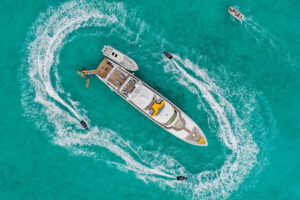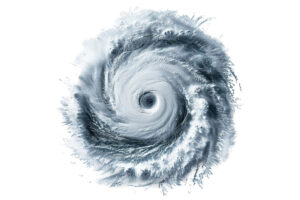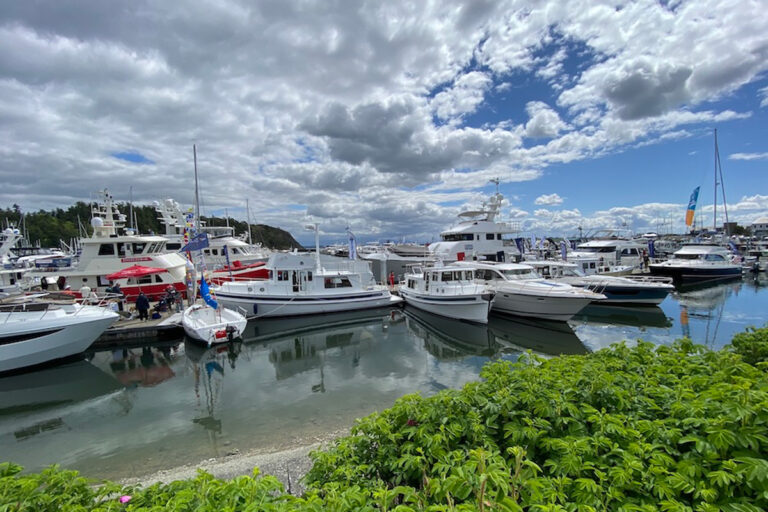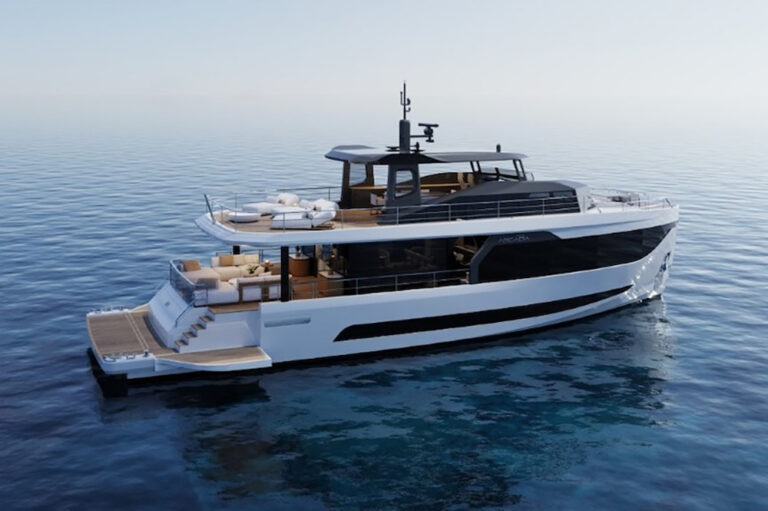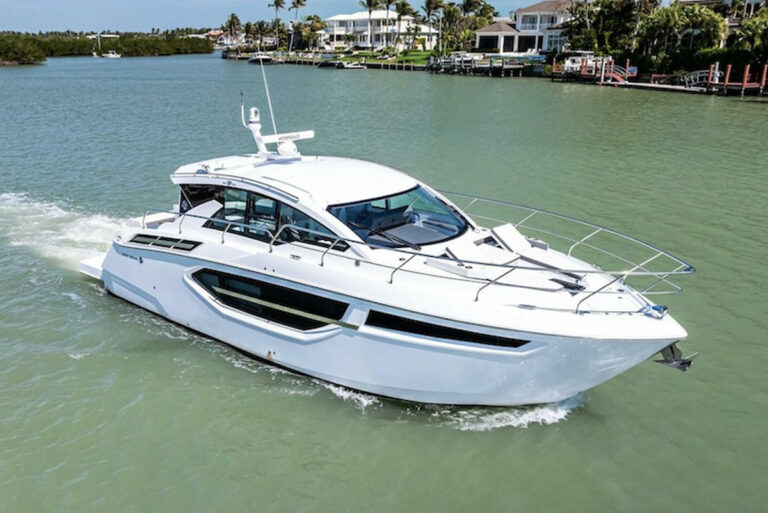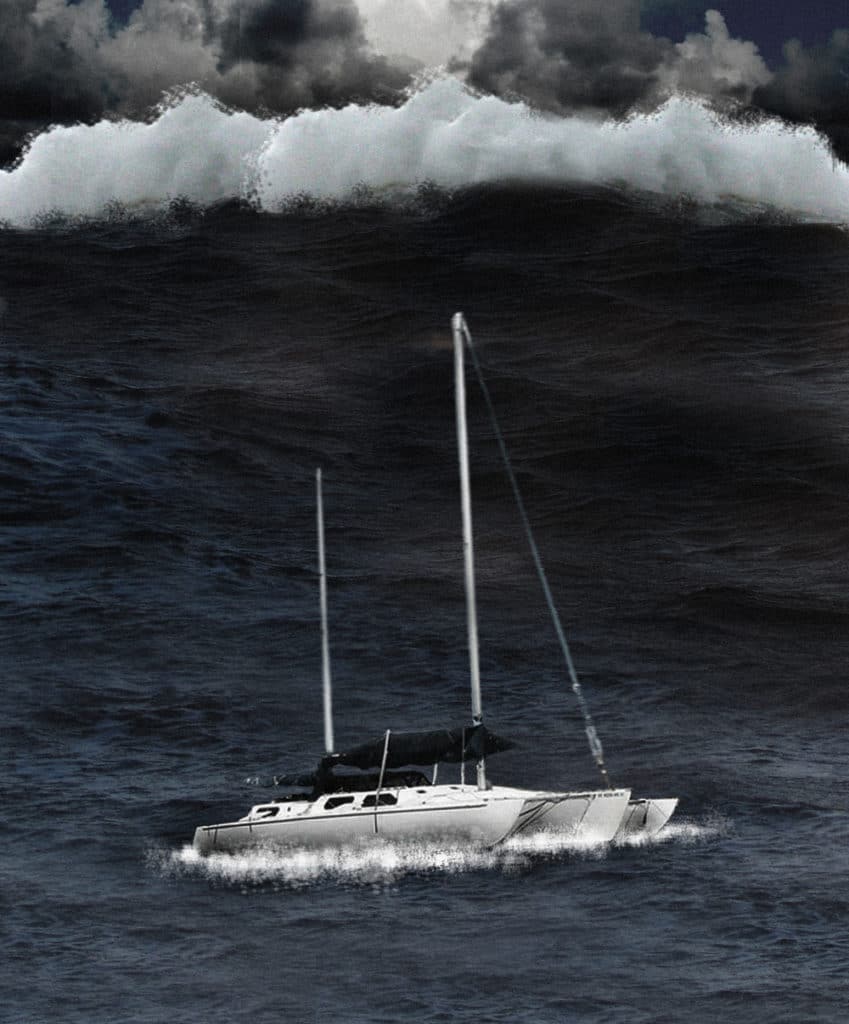
119 Days Upside Down
Horror makes a noise: a roar, like a deep rumble of thunder rolling across the heavens. It was just before sunrise when John Glennie heard it coming—a phenomenal freak wave more than 16 metres high was bearing down on his small yacht like a damburst of water. It was horrifying.
Within seconds the wave had exploded onto the scene, and it dealt with the yacht like a huge tsunami smashing its way across a low-lying island: Anything in its path was destined to be bulldozed out of the way. Suddenly, after three days of battling this ferocious storm off New Zealand’s east coast, the worst fears held by Glennie and his three crew were about to be realised. The 41-foot-long trimaran Rose-Noëlle, which had been lying beam-on to the seas, was engulfed by an avalanche of white water, pitched to 90 degrees then flipped upside down.
Inside the yacht it was as if a house had been inverted in an earthquake. There were shouts amid the darkness as the crew struggled to free themselves from the debris that had crashed down on them. It was a vice-versa world to what they had known a few minutes earlier: Their ceiling was now their floor. Everything that had been below them was now above their heads, and there was a cold ocean swirling into their habitat. Where would it stop? Were they going to sink?
When this calamitous situation stabilized there was just darkness and near silence. Being upside down meant they had been soundproofed from the howl of the storm that raged outside. Before long the water level settled. They were still afloat, and destined to stay that way until…whenever!
For 19 years, Glennie had dreamed of this voyage from his native New Zealand to Tonga and onwards to other enchanting islands in the South Pacific. He was a highly experienced offshore yachtsman with more than 40,000 cruising miles to his credit, and that included sailing in the Roaring Forties. He had designed and built Rose-Noëlle in Sydney a few years earlier based on this experience.
It was now 1989 and his plan was to escape the clutches of the worst of the New Zealand winter, but as the departure date of 1 June drew closer, his frustrations associated with crew selection and the general preparation of the yacht were rising proportionately. His initial desire was to have friends join him for the cruise, but when those friends, who were all good sailors, advised at the last minute they couldn’t make the trip he opted for three people he barely knew, and they had little or no sailing experience. His first recruit was 41-year-old Phil Hofman, who was keen to try bluewater sailing. Surprisingly, he had never ventured in any way outside New Zealand even though he lived aboard his yacht in Picton. Next came another New Zealander, Rick Hellreigel, 31, who had heard that Glennie was looking for crew. He wanted to erase the memories of a disastrous cruise to Fiji some years earlier by giving offshore sailing another chance. Jim Nalepka, 38, was an American cook and the third crewmember to sign on. Even though he had never been sailing, he jumped at this opportunity after Rick, who was a close friend, told him that he was going to make the voyage and suggested they go together.
This happened just a few days before the planned departure, and it was so unsettling for Glennie that, even on the day he was due to cast off, he was wondering if he should put to sea. The thought was also influenced by an unfavourable and stationary weather pattern to the east of New Zealand. However, a last-minute analysis of the conditions convinced him that, while the first stage of the passage would be uncomfortable, it was safe to set sail.
Cook Strait provided a favourable wind and soon Rose-Noëlle was scooting along at up to 16 knots, a speed that impressed all on board. As darkness settled, the wind increased in strength and the seas grew accordingly. It quickly became apparent that it would be a long night ahead: Glennie would have to be alert at all times simply because of the inexperience of his crew. There would be no “breaking-in” period in relatively dormant weather conditions. Even so, he established a watch system where everyone had a two-hour stint on deck and four hours below.
The wind remained strong from the northern sector overnight so Glennie continued on a course away from the coast, a course which he maintained for the next 24 hours. He noted that the barometer was dropping—a sign of deteriorating weather.
“As the day wore on, the wind strength grew and so did the alarm of the crew. I reefed down again and finally dropped the mainsail altogether. Rose-Noëlle was running with the waves under a partly furled headsail, but she wasn’t yet surfing. The conditions were no different to those I had sailed through many times before.
“Phil was on the wheel but was having trouble steering. He seemed really frightened by the strength of the wind and the speed we were doing, yet of the three crew he had the most experience as a sailor. I took the wheel, and the steering felt fine to me, but Phil’s alarm had unsettled the others.”
Rick and Phil called on Glennie to launch a small sea anchor off the stern to help reduce speed, even though he didn’t feel there was any reason for concern: “It was the beginning of a series of events over which I should have taken more control. It was my boat, and I was by far the most experienced person on board.”
While Glennie was convinced they were safe, the anxiety coming from what was by then an increasingly vocal crew saw him acquiesce to their demands. When the sea anchor was set they were 140 miles offshore and still south of the 40th parallel. This was the Roaring Forties— the breeding ground for some of the worst storms imaginable.
From this moment the problems compounded. The gale-force winds strengthened and the breaking seas increased to alarming proportions. Enough, thought Glennie: It was time to lower all sail and set the large parachute sea anchor he had bought for such a situation. It would hold the yacht’s bow into the seas while they rode out the storm.
When this was done, the crew were able to retire to the cabin below, climb into their bunks and wait. For them, there was nothing else they could do.
During the early part of the evening Glennie sensed that the motion of the yacht had changed, and it concerned him. He donned a safety harness, clambered on deck and quickly realised that the parachute anchor had failed. Rose-Noëlle was lying beamon to the seas—the most vulnerable attitude she could take—but Glennie remained confident that even in such extreme conditions, Rose-Noëlle would never turn over. In fact, he was so confident about the stability of the design that he hadn’t fitted escape hatches in the main hull when he’d built the yacht—hatches that would allow the crew to get out in the event of a capsize.
The crew lay in their bunks listening to the fury of the storm that raged outside. The wind was gusting at between 50 and 60 knots and the yacht was being rocked violently from side to side each time the three hulls crested a wave. The atmosphere in the cabin was full of tension and dread, so Glennie tried to calm the situation by turning on the radio and tuning into some soothing music. However, Phil remained at the opposite end of the relaxed scale: “He had steadily worked himself into a panic. Nothing Rick, Jim or I could say or do would calm him down. He was absolutely convinced the boat was going to capsize. He was terrified and at times close to hysteria. He would lie for a few minutes in his bunk, leap up, peer out of the window, and call out, ‘We’re going to flip over. We’re going to flip over.’”
Between 4 a.m. and 6 a.m. on 4 June, the wind began to abate and while the crew were convinced they were seeing the end of the storm, Glennie knew otherwise. A rapid reduction in wind strength was no guarantee that the waves would also abate. A short time later he knew he was right. He heard the roar of what would be their final wave.…
“The death of Rose-Noëlle came quickly. The wave hit her like a freight train roaring out of the darkness towards us, the terrified passengers stalled in its path and trapped inside. There was nowhere to go, nothing we could do. We had only two or three seconds to be frightened, for our guts to clench in that final knot of fear. The giant wall of water came out of the darkness without warning, drowning out all other sound. Its roar overpowered the scream of the wind generator outside, the howl of the wind, the crashing of sea against the trimaran’s hull and decks. It drowned out the sound of the radio playing in the cabin. It drowned out the heartbeat thudding inside our heads.
“The wave hit Rose-Noëlle side-on, and she did not hesitate. Six and a half tons of boat flipped over sideways as if it were a toy plucked from a bath by a child’s hand and dumped unceremoniously on its head. It was 6 a.m., 4 June 1989, mid-winter in New Zealand and still dark.
“The capsize toppled me onto the roof of the cabin above the dinette seat where I had been curled up under a rug, listening to the storm. Rick and Jim were lying in their sleeping bags on the opposite starboard double bunk. When the wave hit they hurtled up in the air and crashed down onto the dinette table below. They landed in a bruised heap on the skylight hatch in the ceiling. I crawled across the roof—now the floor—to join them, water swirling up around our legs.”
With the yacht inverted, its attitude on the sea surface meant that the aft cabin, small as it was, would have to become their principal place of residence as it was the one place where they could build a platform above water level and create a bed. It would be an oppressive, kennel-like environment but in that situation it was their only option.
The natural forces that came with the capsize and the incessant surge of water within the hull created a hellish environment for them in every sense: “The water inside the main cabin had quickly turned to a murky soup after we capsized. A large container of muesli had spilled everywhere and a five-kilo bag of wholemeal flour had split open when it toppled out of a locker beneath the dinette seat. At one stage, Phil watched his camera float past in its case and out through the companionway. Much later he cursed himself for not scooping it up because tucked inside the case was $400 in cash and his new passport.”
Ingenuity was the call of the day as the four inverted sailors struggled to build their new abode. They used blankets, wet weather gear, boots, clothes, cupboard doors and even two dozen toilet paper rolls to create their version of an island bed above water level. Then, with it complete, they crawled one by one through the 23-inch by 23-inch tunnel into the tiny cavity to lie down: “Everything, including our clothes, was soaking wet. We huddled like sardines in a tin in a space as small as a queen-size bed. We had to lie facing the same way, nestled against each other like spoons, wet spoons in a cutlery set. Above us we had just 7 inches of headroom. It was like being trapped in a dark wet cave. Suddenly I remembered the words of a clairvoyant I had visited shortly before leaving on this trip: (You will have an adventure in an underground cave.) Was this it? I wondered.”
Their next two priorities were to search for and secure all the food that could be found in the boat and activate their EPIRB distress beacon. Before long their cache included some tinned food, a three-litre cask of orange juice and soft drink. Rick revealed he had diving skills when he found his way to the submerged fridge and claimed a block of cheese, some butter, two litres of milk and two legs of smoked ham.
“It was a bizarre picnic,” said Glennie of their first meal in 24 hours, “lying soaking wet in the dark with a sickly smell of battery acid still in the air, listening to the fury of the storm. We sliced off pieces of ham with my fishing knife and ate it with cheese and English mustard.”
Incredibly, the thought of rationing their supplies did not go remotely close to entering their minds as they were completely convinced they would soon be rescued. To ensure this would happen, Phil and Glennie moved into the flooded forward cabin where, using what tools they could find, they hacked a hole through the side of the hull leading to the underside of the wing deck that extended between the main hull and outer fl oat: “The toilet was in the way and, as we couldn’t think of a use for an upside-down porcelain pan, we smashed it out with a hammer.”
The EPIRB, which was attached to the side of the hull with the aerial poking outside, was activated and much to their delight the blinking red light confirmed an SOS message was being transmitted to the outside world. It would only be a matter of time before a commercial airliner flew overhead and received that signal—or at least they thought that’s what would happen.
After 40 days of living their nightmare, the four were still managing to survive on food and equipment they were regularly able to scrounge from the submerged lockers within the yacht. For the most part their emotional stability was retained due to a firm belief that they would be rescued at any moment, although Phil maintained his doubts.
However, despite this belief, the three crewmen told Glennie that they wanted to erect a jury rig atop the main hull of the upturned yacht and try to sail back to land: “We had several arguments on this subject because I was convinced our priority was to remain safe and well, and to concentrate on survival, using the resources aboard the boat until we were spotted by a ship or found land. That meant building a reliable water-catchment system and establishing a regular supply of fish, something at which we had been unsuccessful so far.
“To me, the water-catchment system was our top priority as our precious supply of soft drink dwindled and we struggled to survive on three ounces of fluid a day.”
They kept a record of the number of days they had spent drifting by etching marks onto the side of the aft cabin. September 11 was a red-letter day: 100 days since the capsize. They agreed that the time had passed faster than they would have expected.
“All four of us had lost a lot of weight, and Rick and I were particularly thin.
“Phil had lost his big paunch, and in its place were handfuls of skin hanging down from his stomach. When he stripped off to dry out his clothes, he was quite a sight, with his long hair and beard, his sagging skin, and a tattoo of his wife’s name, Karen, on his shoulder.
“Overall we had been blessed with good health during our time adrift. Although we were cold and wet for much of the time during those early days, none of us caught colds. Rick had not suffered from asthma nor been even the slightest bit wheezy. He was dismayed to find that within a week of returning to land he once again needed his inhaler. In the early days Phil used to need medication for his heart condition, but he eventually stopped taking that. Perhaps he’d taken it more from habit than anything else.”
Despite the length of their ordeal and the stifling environment they were living in, the only medical condition that really troubled them was the occasional bout of constipation. Surprisingly, it wasn’t until after the 100th day had passed that they recognised their energy was on a more rapid decline. They were losing muscle tone and looking terribly bedraggled thanks to their gaunt physiques, long and unkempt hair and straggly beards.
“On the afternoon of day 116…I looked up to see a plane flying overhead, low enough to see and hear clearly. We estimated it was about 15,000 feet up and still climbing. It flew directly overhead, and I took a bearing. It was heading magnetic north.”
The four lost souls then spent hours deliberating on how far an aircraft would travel to reach 15,000 feet and decided that it was 80 miles. They also convinced themselves that the aircraft could not have come from Wellington or Christchurch. Taking this information and the direction of their drift they then positioned themselves on a small chart they had retrieved and realised they were heading towards the Hauraki Gulf, which was an outer area of Auckland harbour.
Incredibly this “guess-timation” was almost spot-on because on 28 September they sighted land. Rick, who was perched on the top of the upturned main hull, was transfixed by a dark cloud formation on the horizon which he was convinced was not moving or dissipating. Soon after, Jim joined him and he too noticed, without any prompting from Rick, what appeared to be land low on the horizon. When Glennie went up on deck Rick said casually, “Can you see anything out there?” while pointing in the general direction of the object.
“I spotted the shape instantly. It was a dark image within the cloud, and I knew what Rick and Jim were thinking. ‘It certainly looks like land,’ I replied. ‘Let’s have another look in 10 minutes and see if it’s changed shape.’ It didn’t move, and Rick and Jim told me they had been watching it for a while. When Phil climbed up on deck he stood up and looked around. ‘Land!’ he cried out. ‘That’s land!’”
Excerpted from Hell on High Seas by Rob Mundle. Used by permission of HarperCollins Australia, www.harpercollins.com.au

